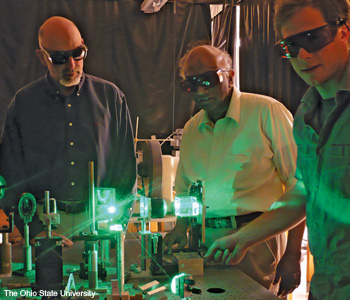Scatterings
Exploring Age-Related Farsightedness
Using a non-invasive light-scattering approach from materials science, a team from Ohio State University sheds light on presbyopia.
 (From left) Optometry professor Mark Bullimore, physics professor Ratnasingham Sooryakumar and physics graduate student Sheldon Bailey
(From left) Optometry professor Mark Bullimore, physics professor Ratnasingham Sooryakumar and physics graduate student Sheldon Bailey
in their Ohio State University lab.
Scientists have known for years that the crystalline lens of the human eye loses its ability to focus on nearby objects with advancing age; many people first notice the condition, called presbyopia, when they reach their 40s and can no longer read without glasses. However, researchers have not yet reached consensus about the exact cause of the condition: Is it an actual stiffening of the lens material, a change in the muscles and ligaments that alters the surface curvature of the lens, or something else?
…Log in or become a member to view the full text of this article.
This article may be available for purchase via the search at Optica Publishing Group.
Optica Members get the full text of Optics & Photonics News, plus a variety of other member benefits.
